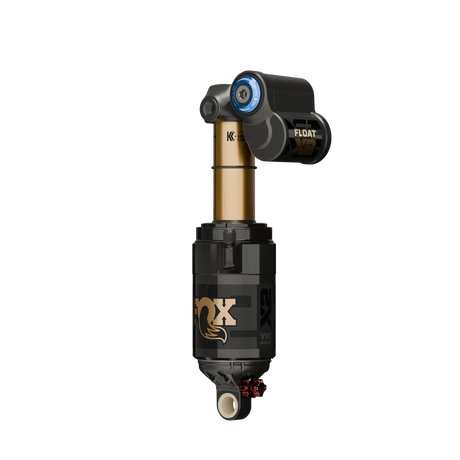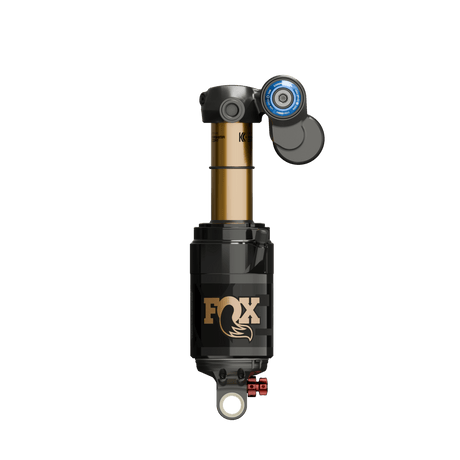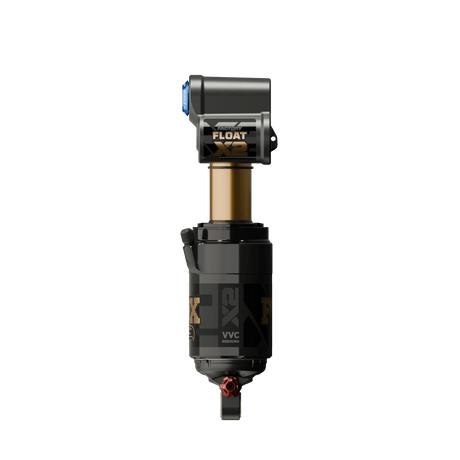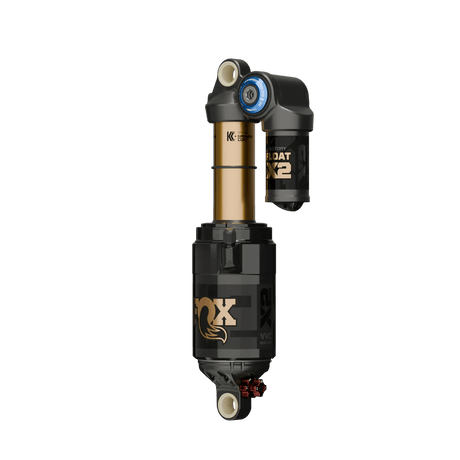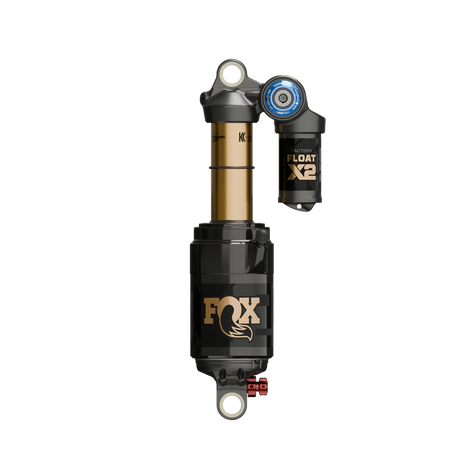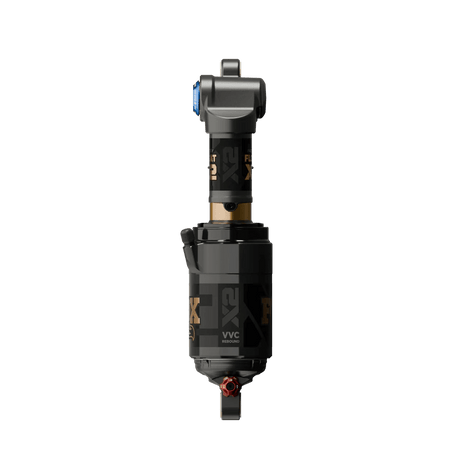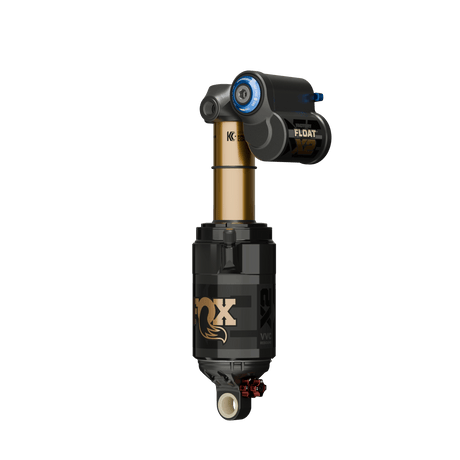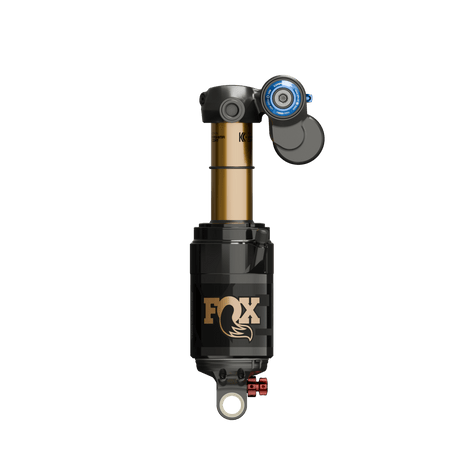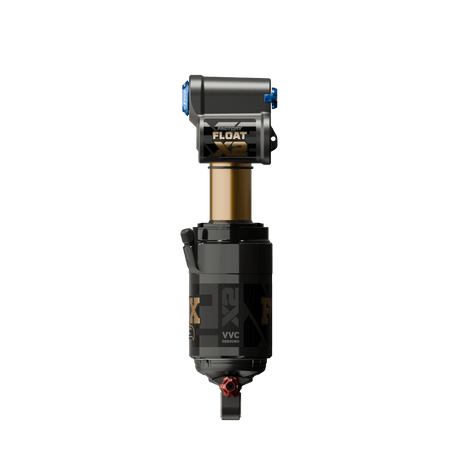Tons of our customers have been asking us whether we recommend a Fox Float X2 or a RockShox Vivid for their bike and the type of riding they do. If you’ve got an enduro or downhill bike, then both of these shocks are great options, and I can guarantee that you’ll be impressed with the performance of either shock. While both shocks are fantastic, you’re looking for the absolute best shock you can get your hands on, and second best just won’t cut it. These two shocks are very similar in a lot of ways, but have some key differences that set them apart from each other. After riding both shocks back to back for months, I’ve split the hairs between them, and while there isn’t a clear winner between them, we’ll break down every difference I’ve found.
Fox Factory Float X2
- High-speed compression 8 clicks
- Low-speed compression 16 clicks
- High-speed rebound 8 clicks
- Low-speed rebound 16 clicks
- Climb switch 2 positions
- Weight 656g (210mm x 55mm)
- $699
RockShox Vivid Ultimate
- High-speed compression 5 clicks
- Low-speed compression 5 clicks
- Hydraulic bottom out 5 clicks
- Low-speed rebound 20 clicks
- Climb switch 2 positions
- Weight 651g (210mm x 55mm)
- $699
Before we get into the comparisons, let’s address the Float X2 in the room. The Fox Float X2 has earned a certain reputation for some reliability issues, and as an authorized fox service center that works on Float X2s all day, we’ve definitely seen our fair share of sad Float X2s. The model year 2021 through 2023 Trunnion mount Float X2 had persistent issues with cavitation and cracking their stanchions, but for 2024, Fox quietly updated the bearing housing seal and redesigned the stanchion to trunnion mount interface to address both of these problems. Since these updates, the Float X2s from 2024 and newer have been far more reliable, and we generally don’t see the 2024 and newer Float X2s come in with these problems anymore. As a bonus, Fox has done a great job of warranting tons of Float X2s and upgrading lots of riders to the new version for no charge.
During my testing, I mounted both of these shocks on my Chromag Lowdown in its mixed wheel size configuration. Chromag has made an incredibly capable rig, with 158mm of rear travel and 170mm of front travel, a steel front triangle paired to an aluminum rear triangle, and aggressive geometry. A bike like this comes alive on rough and fast tracks, so I tested these shocks on one of my favorite local laps, Oriental Express on Galbraith mountain. With rock gardens, straight aways, snaking roots, and plenty of jumps, Oriental Express has served as the perfect repeatable test track to put these shocks through their paces lap after lap. I went for back to back laps one day with both shocks, alternating between different compression and rebound settings to get a good feel for both of them, besides riding them in general day to day life for extended periods of time.
The test sled for these two shocks
Overview
For the last decade, the Float X2 has been the pinnacle of Fox’s air shock lineup, and has gotten updates every few years, but has largely kept the same features and adjustments throughout those revisions. The RockShox Vivid was around in the early 2010’s before going on an extended vacation and returning this year with an all new chassis and some fresh features. There are a few levels of the RockShox Vivid, ranging from just the plain old Vivid up to the Vivid Ultimate, and all Float X2s are the highest end factory version with the Kashima coating. The Vivid Ultimate is the only Vivid you can get aftermarket, so that’s what we’ll be referring to throughout this video, and if you have a lower spec Vivid, you can upgrade it to the Ultimate spec with the RC2T damper upgrade kit.
On the Vivid’s RC2T damper, you’ll find a climb switch, high and low speed compression adjustments, a rebound adjuster, and an adjustable hydraulic bottom out, or HBO for short. On the Float X2, you’ll find a climb switch, high and low speed compression adjustments, and high and low speed rebound adjustments. Inside the air cans of both shocks, riders can add or remove volume spacers to make the shocks more progressive or more linear. Both shocks have the same number of adjustments, 4 dials to tune the damper and volume spacers to tune the air spring, but the Float X2 features the High Speed Rebound knob while the Vivid has the adjustable HBO.
You'll need a multi tool to spin the Float X2 knobs, while the Vivid supplies its own 3mm via the rebound knob
Spec Breakdown
Physically, the shocks are a similar size, but the Vivid is a bit larger when we get the calipers out. The reservoir hangs down a bit further than the Float X2 and the body of the air can is a bit bigger, which could potentially pose an issue with clearance on some bikes. 99.99% of the time this won’t be a factor, but if the shock is going through a tunnel in the seat tube or if the reservoir gets close to the downtube at bottom out, every millimeter makes a difference, and it’s worth checking with the manufacturer for compatibility before buying either of these shocks.
Fox’s Float X2 splits the rebound adjustments into high and low speed rebound, while the Vivid just has one general purpose rebound knob. The differences between high and low speed rebound is a bit complicated to explain, but generally the idea is the high speed rebound controls the speed at which your shock rebounds from deep in its travel, and the low speed rebound controls the speed at which your shock rebounds from the middle of its travel. That’s definitely an oversimplification, and we could talk rebound all day, but giving riders more control over their shock’s rebound is only a positive. High speed rebound has historically only been adjustable by opening and revalving the damper, which is obviously very time consuming and expensive, but Fox has developed what they call VVC which stands for Variable Valve Control, and allows us to adjust our high speed rebound via a little dial on the bottom of the shock. VVC effectively lets you control your shim stack and almost revalve your high speed rebound circuit on the trail, making for an effective tuning tool that most other shocks like the Vivid lack.
What the Vivid doesn’t lack is an adjustable Hydraulic Bottom Out, which tunes the last 20 percent of the stroke, and adds extra hydraulic damping to keep you from getting a super harsh bottom out. Most shocks have an elastomer bottom out bumper to take the edge off when you run out of travel, but those aren’t tunable like the Vivid’s HBO. With 5 clicks of adjustability, you can add or remove bottom out support and get more control over the last 20% of your rear suspension travel than if you were just limited to using volume spacers. Volume spacers impact your entire stroke rather than just the end stroke, and HBO specializes in taking the edge off those jarring bottom out events.
In an effort to get closer to the performance of a coil shock, RockShox developed TouchDown technology for the Vivid, which allows the shock to bypass all of the compression damping and for the first 10% of the shock stroke, making for a completely undamped moment of contact with the ground. TouchDown should make that initial moment of contact more supple and generally reduce breakaway force required to get the shock moving in its travel, making the shock more supple off the top.
Setup
Setting up these two shocks for your first ride is an identical process. I set the sag to 30%, with 245 psi in the Float X2, and 260 psi in the Vivid. Just like all their other shocks, the RockShox Vivid has little tick marks on the stanchion to help you set your sag, which saved me from using the ruler like I did on the Float X2. This is definitely a small difference, considering you really only set your sag once, but quality of life features like this are kind of expected on a seven hundred dollar shock. Luckily, the Float X2 has recommended settings for every adjustment based on your air pressure, so every rider has a good base setting they can build off of. RockShox has recommended rebound settings based on air pressure, and they recommend that every rider starts with both compression circuits in the middle settings regardless of air pressure. Both shocks came specced with one volume spacer, with room for plenty more if necessary.
Tuning the dampers and airsprings of both of these shocks was more painless than I expected. Their recommended settings felt great right out of the box, and after speeding up low speed rebound and increasing compression on both shocks they were right where I wanted them to be. Each click of compression on the Vivid makes a bigger difference than it does on the Float X2, and I would have appreciated slightly smaller jumps for more fine tuning. But on the other hand, the reduced number of clicks increases simplicity and makes for a more approachable tuning process for riders less experienced in setting up suspension. Experienced tinkerers are going to prefer the wider range of adjustment of the Float X2, but I do wish they were tool less knobs instead of needing to grabbing the multi tool all the time.
Who copied who's homework?
Climbing
First, let’s look at climbing characteristics, and both shocks have a version of a climb switch hanging off their dampers. Some people love using these climb switches, while others couldn’t care less, and I’m somewhere in the middle. Long fire road climbs that take over an hour might tempt me to reach down and get a bump in efficiency, while if we’re doing shorter climbs between short descents, I’m just going to leave it open. For the rider that appreciates a firm pedal platform with the climb switch engaged, the RockShox Vivid is going to be much closer to a ‘lockout’ than the Float X2. With how firm the platform is, the Vivid’s climb switch is really only useful on paved roads or very smooth dirt roads, while the Float X2 climb switch is useful in more ‘mountain biking’ scenarios, where you still want your suspension to soak up some bumps but generally just have more compression as you’re making your way up the hill.
When unlocked, these shocks are beautifully responsive to everything you’re crawling over, offering amazing traction through all scenarios. I find it rather counterintuitive that these downhill oriented shocks have such good climbing characteristics, but they’re built for all out traction over anything else, so it makes sense that these shocks are guaranteed to help you make it up those technical climbs. For weight weenies, look elsewhere. These two shocks are as heavy as it gets in the air shock department, with both of them weighing in at about two thirds of a kilogram.
Descending
Unsurprisingly, the Float X2 and Vivid are phenomenal descenders, and if I could somehow blindfold myself while riding them, I’m not sure I could pick them out from each other. Both are so active in their stroke that it’s hard to believe that they’re air shocks. Most air shocks have a slightly stickier sensation through the travel, but both the Float X2 and Vivid have a coil like sensitivity every time they change direction. The feeling is similar to revving a racecar compared to revving a Tacoma. Both are going to rev, but the racecar can fly from redline to redline to idle in a fraction of a second while the Tacome is going to take a couple of seconds to get up to speed and then back again. That’s a bit of an exaggeration, but I stand by my analogy, and the action of both shocks is so light and fluttery when compared to other air shocks like a Float X or a Super Deluxe.
Both the Vivid and Float X2 imitate the suppleness of a coil shock off the top with the progression of an air shock deep in the stroke, and we’re really going to split hairs to set these shocks apart. Off the top, the Vivid is slightly more supple, and feels like it engages in its travel slightly more easily than the Float X2. This was most noticeable when the bike was unweighted and skipping over rocks and roots, and the back wheel felt a little more willing to get up and out of the way of whatever I ran into. This could be because of the TouchDown technology, or there might be less inherent friction in the Vivid than the Float X2 to overcome and get that shock moving. Regardless, I think this category is a bit vain, and doesn’t matter quite as much as the following scenarios.
It’s rare that we’re living in that first 10% of stroke while actually riding a trail, and we’re most often existing somewhere between 30 and 70% of our suspension travel. Overall, in that portion of the stroke, the Float X2 feels slightly more composed, and rides a bit higher in its travel in almost every situation on trail. While it doesn’t have a fancy name like the RC2T Damper found on the Vivid, the Float X2s damper offered a slightly more composed when you’re hauling the mail through chunky sections of trail. I flip flop between clips and flats, but used my Tenet flat pedals during this comparison to get a better understanding of how each shock transmits the trail to my feet. Ideally, I want my feet to stay exactly where they are at all times, but us flat pedal riders know that’s just not the case when you’re pushing the limit, and while riding the Float X2 my feet were where I wanted them more often.
That extra composure comes from the adjustable high speed rebound, which I definitely lean on to keep the bike settled while taking repeated impacts. Adjusting the high speed rebound gives you control over how the shock rebounds from deep in its stroke, and definitely gives you noticeably more control over how the bike reacts to repeated big impacts. One of the reasons suspension feels harsh through rough terrain is that it doesn’t rebound fast enough to have usable travel for the next impact, and tuning both high and low speed rebound independently allows the shock to react to different kinds impacts incredibly well, giving a very settled rear end and keeping your feet in the right place more often.
When it comes to that last 30% of travel, those big bottom out events are always going to be an intense experience. RockShox has done their best to make those off line excursions more controlled with their HBO adjuster, and it works very well. My Chromag frame has plenty of progression baked into its suspension kinematics, so I don’t find bottom out very often with an air shock, so I took some air out and really put the HBO to the test. While the shock isn’t designed for this, I slammed into the HBO circuit pretty damn with 40 psi less in the shock, and there was never a harsh feeling when I cranked up the HBO adjuster. Doing the same with the Float X2 really showed the shortcomings of the elastomer the Float X2 relies on. There wasn’t the same refinement when bottoming out the Float X2, and it really felt like you were at the end of your travel, while the Vivid was a far more controlled landing. So if you’re someone that bottoms out their shock all the time, I would recommend first adding a volume spacer, but if that really doesn’t fix anything the Vivid could be a better choice for you.
Which shock should you buy?
The good news is that both of these shocks are absolutely phenomenal, and there isn’t one that’s better than the other one. Both have subtle strengths and weaknesses, but overall they’re far more similar than they are different. You should buy the shock that makes you more excited to go ride your bike. If that means getting the one that matches your fork or getting the one that your favorite rider uses, that’s great, because there straight up isn’t a wrong decision between them.

